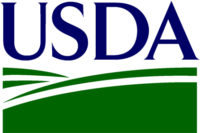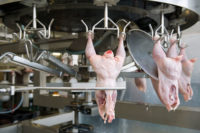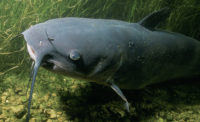TECH FLASH
USDA unveils new poultry inspection system
Under the modernized rule, poultry companies will have to meet new requirements to control Salmonella and Campylobacter while an updated inspection system aims to better position inspectors on the line

In an effort to improve worker safety and prevent thousands of illnesses each year, USDA announced additional food safety requirements and the introduction of the new National Poultry Inspection System (NPIS).
Under the modernized rule, poultry companies will have to meet new requirements to control Salmonella and Campylobacter. In addition, USDA says the NPIS, an updated science-based inspection system, will better position food safety inspectors throughout poultry facilities.
“The US has been relying on a poultry inspection model that dates back to 1957, while rates of foodborne illness due to Salmonella and Campylobacter remain stubbornly high,” said Tom Vilsack, USDA secretary. “The system we are announcing today imposes stricter requirements on the poultry industry and places our trained inspectors where they can better ensure food is being processed safely. These improvements make use of sound science to modernize food safety procedures and prevent thousands of illnesses each year.”
USDA’s Food Safety and Inspection Service will now require all poultry companies to take measures to prevent foodborne illnesses rather than addressing the contamination after it occurs.
For the first time, USDA says poultry facilities will be required to perform their own microbiological testing at two points in their production process to show they are controlling Salmonella and Campylobacter.
Participation in the NPIS is optional. Under the system, poultry companies would sort their own product for defects before presenting them to inspectors, allowing inspectors to focus less time on tasks that have little to do with preventing pathogens and more time on food safety.
USDA says the maximum line speeds for plants using the NPIS will remain at 140 birds per minute, which is consistent with the maximum speed under current inspection programs.
Despite the new provisions, the modernized rule drew criticism from consumer groups that say it does not sufficiently address food safety concerns.
“The final rule still removes inspectors from the slaughter line and turns over certain inspection activities, previously conducted by federal inspectors. Yet the final rule does not require plant employees to be trained in their new duties,” says the Consumers Federation of America (CFA).
Still, some groups, such as the National Council of La Raza (NCLR), a national Hispanic civil rights and advocacy organization, are pleased with the rule, particularly since it does not increase the line speeds. A proposed rule change would have allowed companies to produce 175 birds per minute.
“Responding to a key concern raised by the courageous poultry workers who exposed the human cost of bringing chicken to our dinner plates, Secretary of Agriculture Tom Vilsack and Secretary of Labor Tom Perez today took an important step to prioritize worker safety,” said Janet Murguía, president and CEO of NCLR. “Although life-altering injuries are already far too widespread among this workforce, I am proud to say that the collective efforts of tireless advocates helped the administration prevent a bad situation from becoming worse.”
More information on the new system and the final rule can be found here.
Looking for a reprint of this article?
From high-res PDFs to custom plaques, order your copy today!








